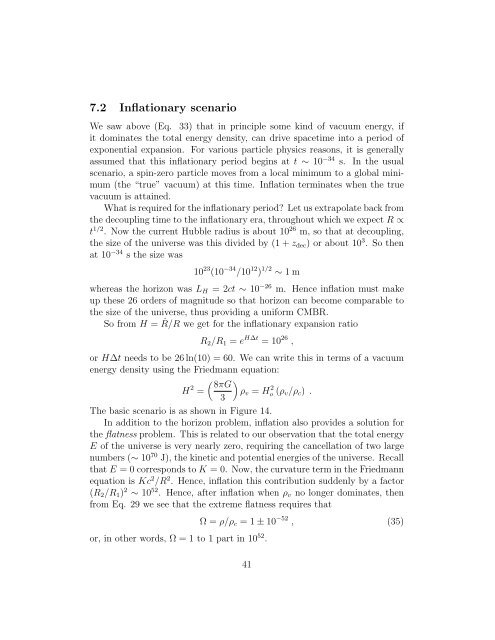Lecture Notes for Astronomy 321, W 2004 1 Stellar Energy ...
Lecture Notes for Astronomy 321, W 2004 1 Stellar Energy ...
Lecture Notes for Astronomy 321, W 2004 1 Stellar Energy ...
You also want an ePaper? Increase the reach of your titles
YUMPU automatically turns print PDFs into web optimized ePapers that Google loves.
7.2 Inflationary scenario<br />
We saw above (Eq. 33) that in principle some kind of vacuum energy, if<br />
it dominates the total energy density, can drive spacetime into a period of<br />
exponential expansion. For various particle physics reasons, it is generally<br />
assumed that this inflationary period begins at t ∼ 10 −34 s. In the usual<br />
scenario, a spin-zero particle moves from a local minimum to a global minimum<br />
(the “true” vacuum) at this time. Inflation terminates when the true<br />
vacuum is attained.<br />
What is required <strong>for</strong> the inflationary period? Let us extrapolate back from<br />
the decoupling time to the inflationary era, throughout which we expect R ∝<br />
t 1/2 . Now the current Hubble radius is about 10 26 m, so that at decoupling,<br />
the size of the universe was this divided by (1 + z dec ) or about 10 3 . So then<br />
at 10 −34 s the size was<br />
10 23 (10 −34 /10 12 ) 1/2 ∼ 1 m<br />
whereas the horizon was L H = 2ct ∼ 10 −26 m. Hence inflation must make<br />
up these 26 orders of magnitude so that horizon can become comparable to<br />
the size of the universe, thus providing a uni<strong>for</strong>m CMBR.<br />
So from H = Ṙ/R we get <strong>for</strong> the inflationary expansion ratio<br />
R 2 /R 1 = e H∆t = 10 26 ,<br />
or H∆t needs to be 26 ln(10) = 60. We can write this in terms of a vacuum<br />
energy density using the Friedmann equation:<br />
( ) 8πG<br />
H 2 = ρ v = Ho 2 (ρ v /ρ c ) .<br />
3<br />
The basic scenario is as shown in Figure 14.<br />
In addition to the horizon problem, inflation also provides a solution <strong>for</strong><br />
the flatness problem. This is related to our observation that the total energy<br />
E of the universe is very nearly zero, requiring the cancellation of two large<br />
numbers (∼ 10 70 J), the kinetic and potential energies of the universe. Recall<br />
that E = 0 corresponds to K = 0. Now, the curvature term in the Friedmann<br />
equation is Kc 2 /R 2 . Hence, inflation this contribution suddenly by a factor<br />
(R 2 /R 1 ) 2 ∼ 10 52 . Hence, after inflation when ρ v no longer dominates, then<br />
from Eq. 29 we see that the extreme flatness requires that<br />
or, in other words, Ω = 1 to 1 part in 10 52 .<br />
Ω = ρ/ρ c = 1 ± 10 −52 , (35)<br />
41













